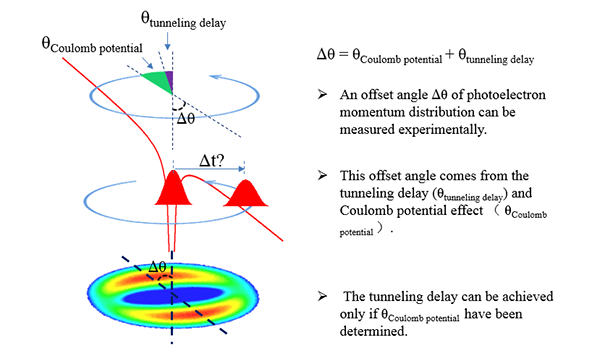Tunneling is one of the fundamental topics of quantum mechanics. Although the issue of tunneling has already been discussed in detail in text books, the consensus on whether tunneling of a particle through a barrier takes a finite time has not been achieved so far. The resolution of this problem is paramount to fully comprehend the tunneling process itself. Attoclock is an intriguing experimental procedure with temporal resolution in the scale of attoseconds to measure the tunneling delay. Specifically, for atoms subject to the elliptically polarized (EP) laser field, the instant when the electron appears in the continuum is mapped to the final angle of the momentum vector in the polarization plane, which can be measured experimentally. As well accepted, the most crucial advantage of the attoclock scheme is that, to achieve temporal resolution in the scale of attoseconds, the attosecond pulse is not necessary any longer, which lowers the technical demand to a great extent and makes this experimental procedure attractive.
Nevertheless, the experimental method of attoclock suffers from some problems, which gives rise to inconsistent conclusion of tunneling delay measurements. One of the most important problems is how to determine the Coulomb potential influence. In fact, during the attoclock experiments, there is an equivalent temporal offset solely induced by the Coulomb potential (TOCP), which cannot be easily separated from the tunneling delay. Usually, TOCP could be larger than tunneling delay. However, it is very difficult to accurately calculate or measure the TOCP. Therefore, as one may expect, the reliability and temporal resolution of attoclock is limited, which may hinder the investigation of the issue of tunneling delay. Based on the semiclassical calculations, the research group from Wuhan Institute of Physics and Mathematics (WIPM) proposes a procedure to extract the TOCP effectively, which might be significant to solve the tunneling delay problem. The research results are published in Chinese Optics Letters, Vol. 18, Issue 1, 2020 (Zhilei Xiao, Wei Quan, Songpo Xu, Shaogang Yu, Yanlan Wang, Meng Zhao, Mingzheng Wei, Yu Zhou, Xuanyang Lai, Jing Chen, Xiaojun Liu. Coulomb potential influence in the attoclock experimental scheme[J]. Chinese Optics Letters, 2020, 18(1): 010201).
To explore the Coulomb potential effect on the attoclock experiments, wavelength dependence of ultrafast dynamics of atoms subject to strong EP laser field has been investigated when the laser intensity is kept constant. To simulate the tunneling delay, numerically, the electron will stay in the origin until the artificial time delay elapses. The influence of the tunneling delay can be extracted by comparing the calculations with and without the time delay. The Coulomb potential has been further introduced in the semiclassical model, where its influence has been investigated. During the calculation, the ultrafast ionization dynamics of several noble atoms, such as H, Ne, Ar, and Kr, have been studied. It has been numerically shown that, when the tunneling delay has been ignored, the ratio of TOCP of the target atom to that of H follows closely to the function of (2Ip)-3⁄2, where Ip is the ionization potential of the system in question. Note that the Ip of H atom is Ip_H =0.5 a.u. Thus the ratio is linearly proportional to the function of (Ip/Ip_H)-3⁄2. That is to say, although the wavelength dependence of TOCP shows a curve with peculiar declining feature, the ratio of the TOCP of the atom in question to that of H becomes insensitive to the wavelength, which can be employed to extract TOCP effectively.
This work has proposed a procedure to extract the TOCP in attoclock scheme, which could be significant to improve the resolution of attoclock and meaningful to solve the problem of tunneling delay.
The research group gave their research plan in the near future. Firstly, the numerical procedures employed in this work are simpleman model and semiclassical method, where some physical effects, such as nonadiabatic tunneling effect, multi-electron influence etc., have been ignored. Hence, further systematical investigations of the influences of the relevant physical effects on their results will be performed soon. Secondly, based on the results of the 1st step, their procedure will be applied to experimentally extract the TOCP in the attoclock experiments for noble gas atoms subject to intense laser fields and, in turn, achieve the tunneling delay precisely. Finally, their procedure will be extended to molecules (e.g., H2, N2, O2).


The schematic of the attoclock procedure.


